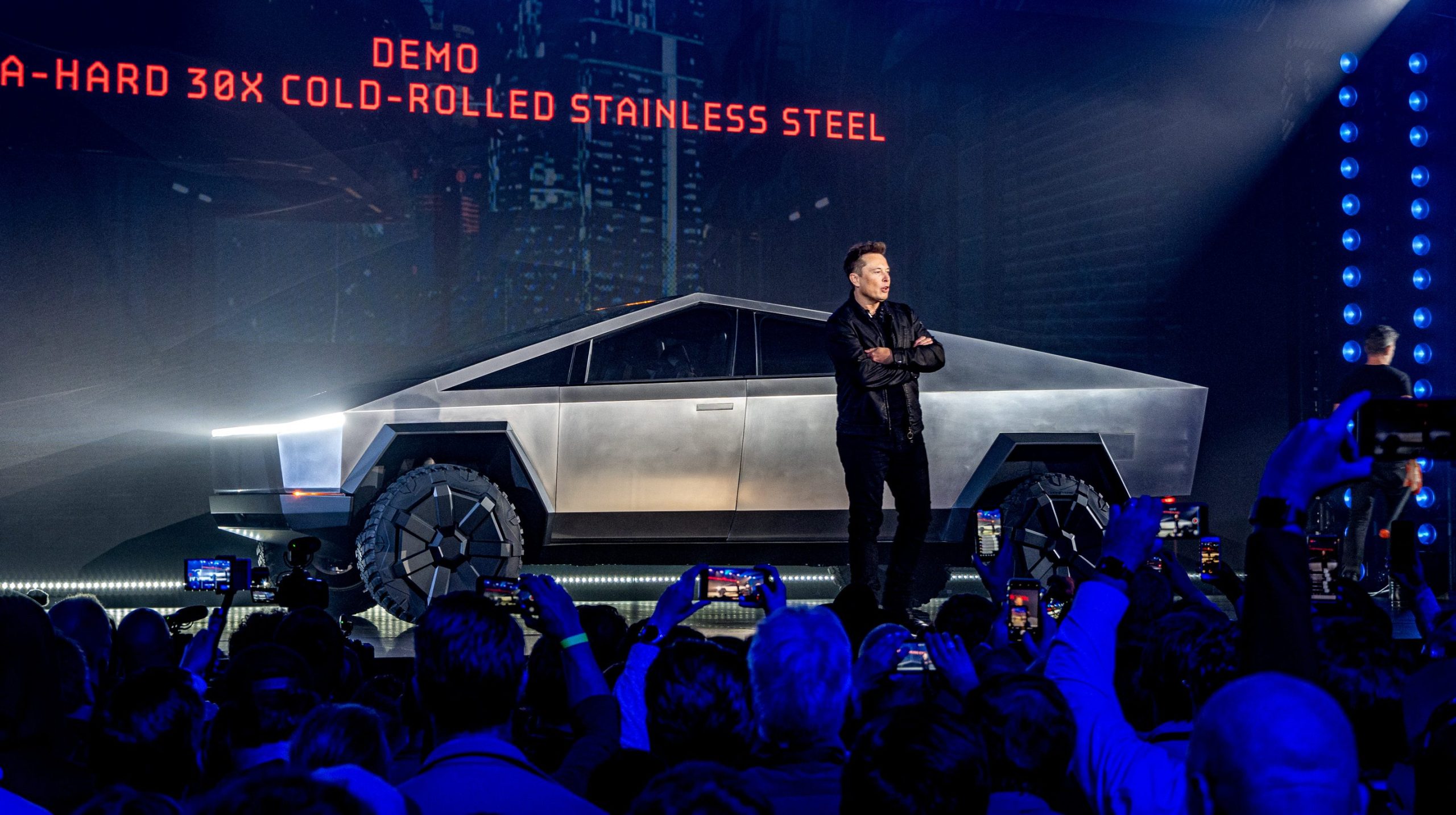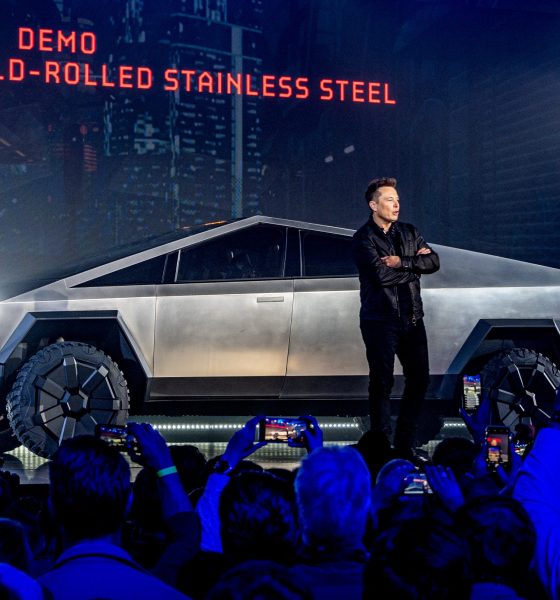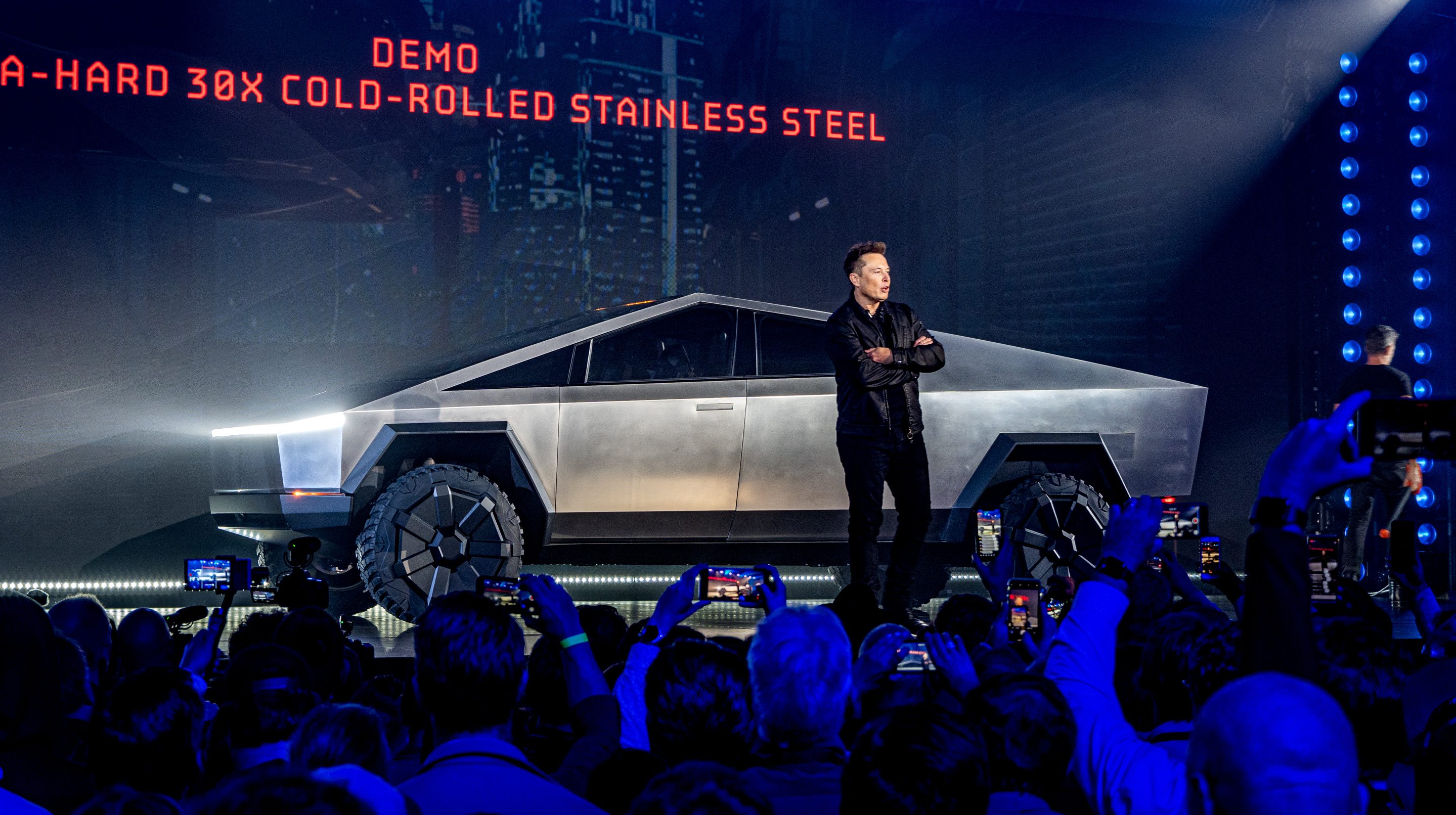

News
Why Tesla can’t ditch the Cybertruck for a traditional pickup design
The Tesla Cybertruck is so “Tesla,” it’s not even debatable. To me, at least. The truck is the true embodiment of everything the electric automaker had stood for during the last seventeen years when it was established in 2003. It breaks all the rules; it goes against the look and feel of “traditional” automotive manufacturing. It is a rebellious statement against the normal boundaries of what a truck is “supposed” to be. Making a traditional, typical, and standard pickup truck would break all of Tesla’s rules, and if the company ends up designing it, it would mean that the legacy automakers have won.
Earlier this week, CEO Elon Musk said that if the Cybertruck happens to tank in sales, Tesla will end up designing a more traditional pickup for the market to consider. Even though I openly said I don’t think that Tesla will have to worry about designing and manufacturing a Cybertruck alternative, the possibility still worries me.
I know what many of you are probably thinking. “Joey, that’s really extreme.” Or, maybe, “Joey, that’s ridiculous, Tesla is just doing what it can to stay competitive in a popular market in case the Cybertruck tanks.”
Sure, I can agree with the second one from an economic standpoint for the company, but I certainly don’t see my point of view as extreme.

Tesla’s Cybertruck, when it was unveiled, shocked the world. It made everyone question what the company was doing. I’ll admit, when I saw that beast roll out onto the stage in Hawthorne, California, I was skeptical. I think I said something along the lines of, “What the hell is that thing?”
But as the presentation went on, I found myself increasingly interested in what Tesla was doing. I realized it was meant to be ridiculous, different, and “polarizing,” as so many people like to call it. It made the entire automotive industry look at the company, and it has worked thus far because it is arguably the most talked-about vehicle in recent memory.
Let’s be honest: Tesla has always broken the rules. Skeptics said the Model S would fail. It didn’t. They said Tesla couldn’t attain a considerable or acceptable range for its EVs. The company did and has scrapped vehicle models that aren’t capable of “acceptable range” of over 250 miles. They said the company couldn’t make an affordable vehicle. The Model 3 and Model Y are both mass-market cars geared toward affordability. They said Tesla couldn’t turn a profit. It just did, for the fourth consecutive quarter.
Tesla has always done what people said wasn’t possible. The Cybertruck is just one of the latest examples.
When the Cybertruck was unveiled, people said, “Nobody will buy that.” “It’s ugly.” “Even if people buy it, it won’t perform well against petrol-powered pickups.”
It has a substantial amount of pre-orders. According to CybertruckOwnersClub’s reservation number decoder, it has over 750,000 pre-orders.
It may be ugly to some, but that’s an opinion and subjective. I find the truck unique and beautiful in its own way.
The Cybertruck won a Tug-of-War against an F-150.
There are those three theories debunked.
This is a preview from our weekly newsletter. Each week I go ‘Beyond the News’ and handcraft a special edition that includes my thoughts on the biggest stories, why it matters, and how it could impact the future.
A big thanks to our long-time supporters and new subscribers! Thank you.
But more significant than that, the Cybertruck is really an embodiment of Tesla’s mission as a whole. It has always been to prove the doubters wrong, to change the way people look at cars. Before Tesla, people saw their everyday drivers as a way to get from Point A to Point B. Some were faster than others, some were louder than others, and some had better stereos than others. The point is, when Tesla’s came out, their vehicles became more than a daily transportation outlet. They became entertainment machines, and they changed the way the world looked at a car.
The Cybertruck did the same thing. It changed the way people looked at trucks, even though nobody has one yet. It is a summarization of what Tesla has always meant and tried to convey to people. Change the way people look at something, and the possibilities become limitless. Before the Cybertruck, people thought that the “truck” had to have a cab, a bed, and look nearly the same as every other pickup on the market. But that’s the thing. Tesla has never used the rules or the “typical” idea for anything. That’s what makes Tesla, Tesla.
People knew battery-powered cars were possible, but nobody was good at it. The other car companies in the world were too focused on making their petrol engines more advanced at the time. After all, nobody was anxious about climate change at the time. At least, it wasn’t widely accepted by people until the mid-2000s from what I remember.
Tesla changed all of that. They proved electric cars didn’t have to be slow, or boring “like a golf cart,” as Elon Musk once said.
In my opinion, we won’t see a traditional Tesla truck. I don’t think the Cybertruck will tank in terms of sales, and I don’t believe that Tesla will be interested in being just another car company that makes a truck that looks like everyone else’s.
The Cybertruck goes against all the rules, and that’s more “Tesla” than anything.
Please consider Subscribing and joining me next week as I go ‘Beyond the News’

Investor's Corner
Tesla gets price target bump, citing growing lead in self-driving

Tesla (NASDAQ: TSLA) stock received a price target update from Pierre Ferragu of Wall Street firm New Street Research, citing the company’s growing lead in self-driving and autonomy.
On Tuesday, Ferragu bumped his price target from $520 to $600, stating that the consensus from the Consumer Electronics Show in Las Vegas was that Tesla’s lead in autonomy has been sustained, is growing, and sits at a multiple-year lead over its competitors.
CES 2026 validates Tesla’s FSD strategy, but there’s a big lag for rivals: analyst
“The signal from Vegas is loud and clear,” the analyst writes. “The industry isn’t catching up to Tesla; it is actively validating Tesla’s strategy…just with a 12-year lag.”
The note shows that the company’s prowess in vehicle autonomy is being solidified by lagging competitors that claim to have the best method. The only problem is that Tesla’s Vision-based approach, which it adopted back in 2022 with the Model 3 and Model Y initially, has been proven to be more effective than competitors’ approach, which utilizes other technology, such as LiDAR and sensors.
Currently, Tesla shares are sitting at around $433, as the company’s stock price closed at $432.96 on Tuesday afternoon.
Ferragu’s consensus on Tesla shares echoes that of other Wall Street analysts who are bullish on the company’s stock and position within the AI, autonomy, and robotics sector.
Dan Ives of Wedbush wrote in a note in mid-December that he anticipates Tesla having a massive 2026, and could reach a $3 trillion valuation this year, especially with the “AI chapter” taking hold of the narrative at the company.
Ives also said that the big step in the right direction for Tesla will be initiating production of the Cybercab, as well as expanding on the Robotaxi program through the next 12 months:
“…as full-scale volume production begins with the autonomous and robotics roadmap…The company has started to test the all-important Cybercab in Austin over the past few weeks, which is an incremental step towards launching in 2026 with important volume production of Cybercabs starting in April/May, which remains the golden goose in unlocking TSLA’s AI valuation.”
Tesla analyst breaks down delivery report: ‘A step in the right direction’
Tesla has transitioned from an automaker to a full-fledged AI company, and its Robotaxi and Cybercab programs, fueled by the Full Self-Driving suite, are leading the charge moving forward. In 2026, there are major goals the company has outlined. The first is removing Safety Drivers from vehicles in Austin, Texas, one of the areas where it operates a ride-hailing service within the U.S.
Ultimately, Tesla will aim to launch a Level 5 autonomy suite to the public in the coming years.
Elon Musk
Elon Musk’s Biggest Revelations on AI, Robots, and the Future of Work from the Moonshots Podcast

Elon Musk’s appearance on the Moonshots with Peter Diamandis podcast was packed with bold predictions, candid admissions, and surprising tech insights. The nearly three-hour conversation covered everything from artificial intelligence to humanoid robots, geopolitics, and the future of work. Here are the top 10 most intriguing takeaways:
-
Aggressive AGI Timeline Predictions
Musk offered a detailed view on when artificial general intelligence (AGI) could emerge, suggesting it may arrive sooner than many expect, emphasizing both transformative potential and risks.
-
U.S. vs. China in the AI Race
He discussed the strategic competition between the United States and China over AI development, noting that geopolitical dynamics will shape how and who leads in the next decades.
-
Future of Job Markets
Musk touched on how AI and automation could reshape employment, predicting massive boosts in productivity alongside potential disruptions in traditional work structures.
-
Clean Energy Transition
A recurring theme was the role of clean energy in future economies, with Musk reiterating the importance of scaling sustainable power generation and storage.
-
Humanoid Robots Are Coming
On the podcast, Musk elaborated on Tesla’s work on humanoid robots, hinting at timelines and applications that go beyond factories to general-purpose assistance.
-
Tesla Roadster “Last Human-Driven Car”
Outside the core discussion topics, Musk teased features of the upcoming Tesla Roadster — calling it “the best of the last of the human-driven cars” and suggesting safety won’t be its main selling point.
-
The Role of AI in Clean Energy and Robotics
Linking AI to both energy optimization and robotics, Musk explained how smarter systems could accelerate decarbonization and task automation across industries.
-
U.S. Innovation Leadership
Musk argued that maintaining American leadership in key tech sectors like AI, space, and robotics should be a national priority, with thoughtful policy and investment.
-
Job Creation vs. Job Elimination
While acknowledging automation’s disruptive effects, he also outlined scenarios where new industries and opportunities could emerge, particularly in AI, space, and advanced manufacturing.
-
Long-Term Vision for Humanity
Throughout the conversation, Musk revisited his long-term philosophical views — including a belief in humanity’s responsibility to become a multi-planetary and technologically empowered species.
Whether you agree with Musk’s optimism or not, the podcast offers a window into the thinking of one of the most influential figures in tech today, in and why his visions continue to spark debate and inspiration.
Elon Musk
Elon Musk just said some crazy stuff about the Tesla Roadster

Elon Musk appeared on the Moonshots podcast with Peter Diamandis today to discuss AGI, U.S. vs. China, Tesla, and some other interesting topics, but there was some discussion about the upcoming unveiling of the Roadster, the company’s electric supercar that will arrive several years after it was initially slated for release.
Musk made some pretty amazing claims about the Roadster; we already know it is supposed to be lightning-fast and could even hover, if Tesla gets everything to happen the way it wants to. However, the car has some pretty crazy capabilities, some of which have not even been revealed.
On the podcast, Musk said:
“This is not a…safety is not the main goal. If you buy a Ferrari, safety is not the number one goal. I say, if safety is your number one goal, do not buy the Roadster…We’ll aspire not to kill anyone in this car. It’ll be the best of the last of the human-driven cars. The best of the last.”
🚨 Elon on the Roadster unveiling, scheduled for April 1:
— TESLARATI (@Teslarati) January 6, 2026
Musk makes a good point: people who buy expensive sports cars with ridiculous top speeds and acceleration rates do not buy them to be safe. They hope they are safe in case of an emergency or crash, but safety is not at the forefront of their thoughts, because nobody buys a car thinking they’ll crash it.
The Roadster is truly going to push the limits and capabilities of passenger vehicles; there’s no doubt about that. Tesla plans to show off the new version car for the first time on April 1, and Musk has only hinted at what is possible with it.
Musk said back in November:
“Whether it’s good or bad, it will be unforgettable. My friend Peter Thiel once reflected that the future was supposed to have flying cars, but we don’t have flying cars. I think if Peter wants a flying car, he should be able to buy one…I think it has a shot at being the most memorable product unveiling ever. [It will be unveiled] hopefully before the end of the year. You know, we need to make sure that it works. This is some crazy technology in this car. Let’s just put it this way: if you took all the James Bond cars and combined them, it’s crazier than that.”
Production is set to begin between 12 and 18 months after the unveiling, which would put the car out sometime in 2027. Hopefully, Tesla is able to stay on track with the scheduling of the Roadster; many people have been waiting a long time for it.








